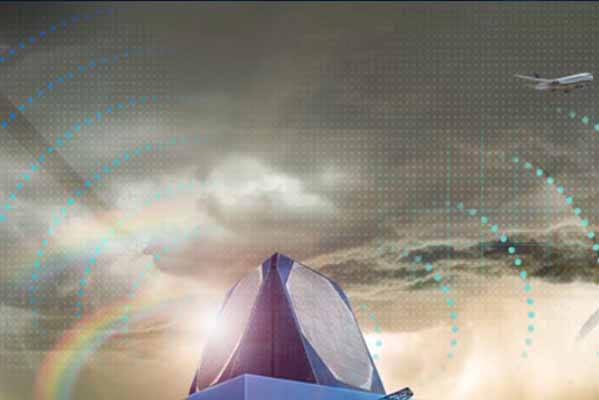What if you could detect a tornado with greater confidence minutes before the funnel reached the ground, posed a grave danger to life, and tracked its path along the ground with much greater accuracy?
Today, meteorologists, data scientists, and engineers at the University of Oklahoma’s Advanced Radar Research Center (ARRC), in collaboration with Analog Devices Inc. (ADI), are designing, building, testing, and fielding a next-generation, all-digital polarimetric phased array radar system. The breakthrough innovation funded by NOAA’s National Severe Storms Laboratory (NSSL) will allow for real-time monitoring, improved forecasting, and the earlier detection of severe weather than anything that has come before.
“With the advanced radar system, we can see the detailed structure of the storm and detect rotating winds earlier, enabling much better warning time, reducing injuries, and preventing the loss of life,” said Bob Palmer, ARRC Executive Director and Meteorology Professor.
ARRC’s new breed of radar pioneers must overcome significant size, weight, power, and cost (SWaP+C) hurdles, and daunting computational power challenges.
At A Glance
ARRC Research Organization
Established in 2005, the University of Oklahoma’s Advanced Radar Research Center (ARRC) is the preeminent academic institution for enhancing safety, security, environmental quality, and economic prosperity through the research and development of advanced radar solutions.
Technology
A radar solution with decreased latency and increased resolution, accuracy, and data quality. Use advanced signal processing, phased array radar, and retrieval algorithms for enhanced severe storm observations.
Challenge
Push the limits of technology and propose a cost-effective, reliable solution based on sound engineering and scientific principles. Enable large-scale, all-digital, phased array beamforming architectures and transceivers that reduce size, weight, and power (SWaP).
Goal
Prevent the loss of life and property with enhanced detection and improved forecast models. Apply new radar technology to a broad range of applications to observe natural and man-made hazards. Reduce risk through a better understanding of the phenomena.
At The Center Of The Storm

Norman, OK—the state with the distinction of the most tornadoes in the world. It is here that a team of innovators at the Advanced Radar Research Center (ARRC) is developing a breakthrough radar solution offering a wider window to the early identification and continuous monitoring of severe weather. Advancements in early detection will result in more informed decisions, enabling the deployment of early warning notifications and emergency response services—protecting property, reducing injuries, and saving lives.
ARRC is focused on extending the radar’s borders and providing greater accuracy with an all-digital radar technology capable of producing hundreds of highly targeted phased array beams sweeping an area continuously and creating a real-time, high resolution image. ARRC’s all-digital solution has wide-ranging applications, from better weather forecasts and meteorological research to enhanced aircraft tracking and noncooperative aircraft surveillance.

Radar Engineer, ARRC
“Back in early 2015, ARRC invited ADI to their research facility to attend a presentation about its phased array research initiative,” said Wyatt Taylor, Marketing Director, Multimarket Platform Group, ADI. ARRC was using our AD9361 chip as a prime component up to that point in time. “The chip was the first indication we might be able to construct an all-digital phased array radar, making severe storm and early tornado detection possible,” said Matt McCord, ARRC Radar Engineer.
ADI gave ARRC a heads-up about a next-generation integrated chip it was developing—the AD9371, a high performance wideband RF transceiver replacing as many as 20 discrete components while maintaining low power consumption levels. ARRC’s lead technologist expressed interest in examining the unreleased, not yet public documented chip and was granted early access.
“We worked on migrating through the eval boards and issues related to calibration,” said McCord. “ADI provided updates, app support, and information sharing session, and provided us with other parts, including power monitors—the gatekeepers for our whole system—and the ADP5054, an enabling technology we use extensively for power supply”, he explained.
Project Horus: The Holy Grail Of Weather Observation
Later, after meeting with ADI, ARRC initiated research on Project Horus, an early high resolution, all-digital phased array radar funded by the NOAA National Severe Storms Laboratory (NSSL) in Norman. Currently, the prototype is on the scale of a demonstrator system. ARRC selected ADI’s all-digital waveform generators and receivers, low power, low latency, integrated data processing microchip, high performance data converters, and DSP to include behind every ‘element’ (antenna) on its all-digital mobile radar system.

All-Digital Radar: A Giant Leap Forward
All-digital phased array radar systems hold the promise of producing many more beams, tracking many more targets, at a much higher resolution than existing radar systems.
Like its analog phased array ‘cousin’, all-digital’s computer commands steer the radar beam, enabling the system to rapidly scan specific areas without using mechanical hardware, motors, or spinning radar dishes. But analog phased arrays are limited in performance by hardware. Analog systems can only create a few RF beams or ‘slices’ in the vertical dimension—putting a cap on both resolution and the number of targets tracked at any one time. Digital systems, in addition to overcoming these limitations, can also ‘evolve’ new capabilities simply via software upgrades.

Analog And Conventional ‘2d’ Radar
Conventional radar generates a limited number of beams in the horizontal dimension, producing a slice of low resolution information.
Source:
https://www.analog.com/en/signals/articles/saving-lives-with-all-digital-radar.html















